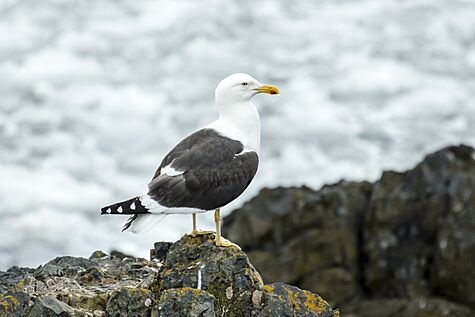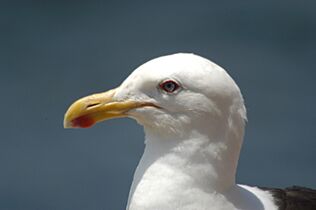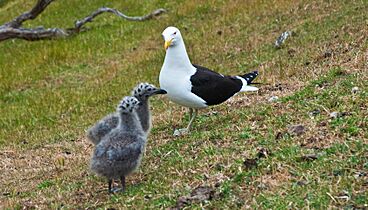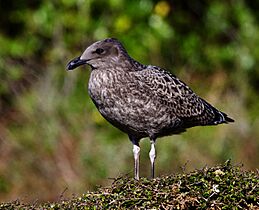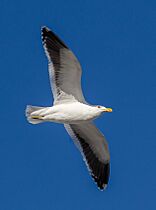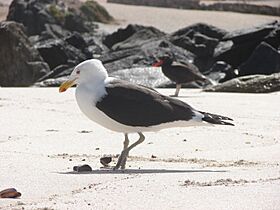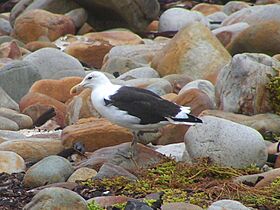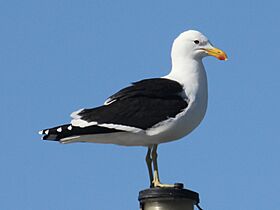Kelp gull facts for kids
Quick facts for kids Kelp gull |
|
|---|---|
|
|
|
| Adult in Livingston Island, South Shetland Islands | |
| Conservation status | |
| Scientific classification | |
| Genus: |
Larus
|
| Species: |
dominicanus
|
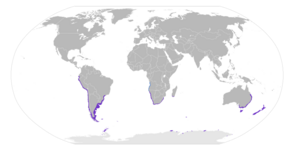 |
|
The kelp gull (Larus dominicanus) is a type of gull that lives along coasts and on islands. You can find them in many parts of the Southern Hemisphere. Another name for it is the Dominican gull.
In New Zealand, this bird is often called the black-backed gull or southern black-backed gull. Its Māori name is karoro. In Southern Africa, a specific type of kelp gull is known as the Cape gull. The name "Dominican" comes from the Dominican Order of friars, who wear black and white robes, just like the gull's feathers.
Contents
What Does a Kelp Gull Look Like?
Kelp gulls look a bit like other gulls found in the Atlantic Ocean. They are a medium-sized bird. These gulls are about 54 to 65 centimeters (21 to 26 inches) long. Their wings can spread out from 128 to 142 centimeters (50 to 56 inches).
Adult kelp gulls have black feathers on their upper parts and wings. Their head, belly, tail, and wing tips are bright white. Their beak is yellow with a red spot. Their legs are a greenish-yellow color. This color gets brighter when they are ready to breed. Their call sounds like a loud ki-och.
Young kelp gulls look different. They have duller legs and a black beak. Their feathers are mostly grey-brown with whitish edges. They also have a dark band on their tail. It takes them about three or four years to grow into their adult feathers.
Different Types of Kelp Gulls (Subspecies)
There are five different types, or subspecies, of the kelp gull. One of these, the African subspecies L. d. vetula, is sometimes called the Cape gull. The Cape gull has a more angled head and a smaller, shorter beak. Adult Cape gulls usually have dark eyes, while other kelp gulls often have pale eyes. Young Cape gulls look very similar to other young kelp gulls.
Here are the main subspecies:
- L. d. dominicanus: Found in South America, the Falkland Islands, South Georgia Island, Australia, and New Zealand.
- L. d. vetula: Found in Southern Africa.
- L. d. judithae: Lives on subantarctic islands in the Indian Ocean.
- L. d. melisandae: Found in southern and southwestern Madagascar.
- L. d. austrinus: Lives in Antarctica and nearby Antarctic islands.
Kelp Gull Behavior and Diet
Kelp gulls are omnivores, meaning they eat both plants and animals. Like most gulls, they are good at finding food. They will eat many different things. They often search for food at landfills. A big increase in their numbers can sometimes mean the environment is not healthy.
Kelp gulls have been seen feeding on large animals like right whales. They use their strong beaks to peck at the skin. This can leave the whales with open sores. This behavior has been seen in waters near Argentina.
Along rocky coasts, like at Boulders Beach in Cape Town, kelp gulls are clever. They pick up shellfish and fly high into the air. Then, they drop the shells onto the rocks below to break them open. This helps them get to the soft meat inside.
Reproduction and Life Cycle
Kelp gulls build their nests on the ground. A nest is a shallow dip lined with plants and feathers. The female usually lays two or three eggs. Both the mother and father kelp gulls work together to feed their young chicks.
Gallery
- Kelp gull
-
At Concón, Chile
-
Subspecies L. d. dominicanus stealing a meal of shellfish from blackish oystercatchers in Bahía Inglesa, Chile
Cape Gull (Larus dominicanus vetula or Larus vetula)
- Cape gull
-
Cape gull (L. d. vetula), Boulders Beach, South Africa
-
Cape gulls searching for food in South Africa
The Cape gull is a specific type of kelp gull found in Southern Africa. It has darker eyes and is generally larger than other kelp gulls. Its beak is also bigger. Scientists believe there are about 11,000 breeding pairs of Cape gulls in Southern Africa, and their numbers are growing.


